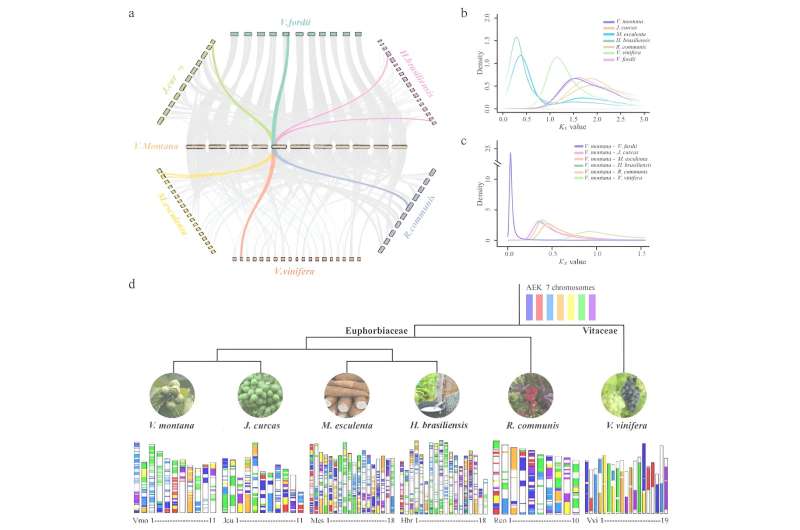This article has been reviewed according to Science X's editorial process and policies. Editors have highlighted the following attributes while ensuring the content's credibility:
fact-checked
peer-reviewed publication
trusted source
proofread
Vernicia montana's genome unearths new breeding horizons

A study has unveiled the genetic blueprint of Vernicia montana, a plant renowned for its high-value tung oil and ornamental beauty. The research decodes its chromosome-level genome, providing unparalleled insights into its evolution and setting the stage for advanced molecular breeding and sex identification methods. This discovery is poised to revolutionize agricultural practices, ensuring sustainable production and genetic enhancement of this economically vital species.
Commonly known as the tung oil tree, Vernicia montana plays a critical role in producing high-quality tung oil. However, breeding efforts have been hindered by the lack of genomic data, especially in early sex identification.
Distinguishing male from female trees early is essential for optimizing breeding, as female trees yield significantly more oil. Addressing these challenges, the study highlights the urgent need for a genomic-based method to accurately and rapidly identify sex in V. montana.
Conducted by researchers from the Central South University of Forestry and Technology and published in Horticulture Research on May 18, 2024, this study bridges the genomic information gap for Vernicia montana. It presents a high-quality chromosome-level reference genome of a male tree, laying a robust foundation for future molecular breeding research. The study also identifies a sex-linked insertion-deletion (InDel) marker, offering a precise tool for determining the gender of V. montana, marking a significant leap forward for breeding programs.
The genome assembly of Vernicia montana reveals crucial insights into its evolutionary history and genetic traits. Researchers have pinpointed genes linked to stress resistance and flavonoid synthesis, vital to the species' adaptability. A key discovery is a sex-linked InDel marker on chromosome 2, which reliably distinguishes male from female trees.
This marker, homozygous in males and heterozygous in females, suggests a possible ZW sex-determination system. Its availability enables early sex identification in breeding programs, streamlining the selection of high-yielding female trees. This innovation is set to significantly boost the productivity and sustainability of tung oil cultivation through optimized breeding strategies.
Dr. Lin Zhang, the senior author, underscored the significance of the findings, saying, "The identification of a reliable molecular marker for sex determination in Vernicia montana marks a major milestone for breeding programs. This breakthrough not only speeds up the selection process for high-yielding female trees but also deepens our understanding of the genetic mechanisms behind sex determination in dioecious plants."
The implications of this study extend far beyond breeding. Early and accurate sex identification in Vernicia montana will refine breeding strategies, leading to higher oil yields and better resource allocation. Moreover, the insights into stress resistance genetics will drive the development of more resilient varieties, enhancing the long-term sustainability and profitability of V. montana cultivation.
More information: Genome assembly and resequencing shed light on evolution, population selection, and sex identification in Vernicia montana, Horticulture Research (2024). DOI: 10.1093/hr/uhae141
Journal information: Horticulture Research
Provided by NanJing Agricultural University



















